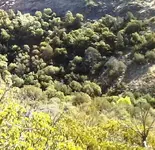Roy,
[The slag built into the very walls of the missions in Arizona, the string of silver mines in Arizona, the impressive treasures found in Brazil and Spain, are "non-specific evidence"? Would you also class the various statements cited from father Nentvig, Och, Segesser et al, also as "non-specific"?]
No, I don't find those statements specific enough to make them convincing that the Jesuits were involved in mining. As I have said before, I don't doubt that some priests were breaking that rule, maybe bending it.
As for the slag in the walls........Who built the walls, when were they built and how much slag was at the location? Was the slag actually in the structure or just on the exterior coating?
Whom built the two missions mentioned? Are they not credited to the Franciscans? So we have two missions, built by Franciscans, which have slag built into the exterior coatings where it is visible. Who knows if it is inside of that, but considering that it is apparently put there for decorative effect, it seems unlikely. Most historians credit the construction of these two churches to the Franciscans BTW. It should be safe to assume that the slag was on the spot when the churches were built, and not imported from some distant point. So we have mounds of slag reported at several missions, slag built into the very walls of two of them; bell casting evidence at Guevavi and Tumacacori. Yeah I must be completely hare-brained to be making any conclusions from that!
Cactusjumper also wrote
For the record, I don't just read the history of the missions written by the Jesuits, but admit to having many of their books as they used the writings of the mission priests as sources. I have had personal contact with many of those authors over a number of years. None believed that the Jesuits were involved in extensive mining. They are all much more educated on Jesuit mission history than I am. They have all searched the pertinent archives in Mexico, which I have not. I don't know about the others who are posting here.
Perhaps I should make a point here - I do
not care what any historians have to say about anything, when I research it
myself. Biases and opinions color the works of all historians. Plus as far as I can determine, virtually NO historian of modern times, has shown the slightest bit of interest in any mining activities in the southwest, Jesuit or otherwise. On the other hand, the only kind of "historian" that HAS shown an interest in this aspect of history, namely the good geologists of the USGS, whom have bothered to research the history of the respective areas they were studying, have in fact attributed considerable mining activities TO the Jesuits, and included those piles of slag, the smelters (which are not to be seen today) the charcoal pits etc
as solid evidence to support their contention. Of course you are certainly free and welcome to accept ANY conclusions of any consensus of historians, just as you are free to accept the consensus of scientists about global warming, but nothing prevents ME from arriving at my own conclusions. I can list other examples where I personally disagree with a
great majority of modern historians, like the existence of Atlantis, whether Phoenicians reached the Americas (though that situation has been changing a bit) just for starters, so you are welcome to classify me among the Tinfoil Hat Brigade or those glassy-eyed "dreamer" type treasure hunters all too ready to believe anything in the way of treasure. Historians can and do get things wrong, and when a powerful influential group exerts pressure, historians are not above bending to that pressure. BTW, MOST of the OLDER historians, those closer to the events, state that the Jesuits were the pioneer miners (and smelters) in Arizona.
Doesn't it tell you something, that here in just Arizona as an example, we have "legends" of Jesuit mines, a whole string of silver mines and a few gold, corresponding to a set of mines mentioned by Jesuit father Nentvig, mounds of slag found at two missions and slag built into two (not the same two), the lavish description of how well "ornamented" even the little "visita" missions were of the Jesuits, the massive silver altar seen at San Xavier, and all of this is supposed to
not indicate what the simplest answer is, that the padres (of both Orders) were actively mining and smelting. To me, that is stretching it too much to try to dismiss the whole body of evidence, which apparently some are happy to do, inventing imaginary Spanish miners for the mines and smelting, that the Indians were making up stories to "lure tourists" <

??> and judging the wealth of the Jesuits by the pittance found there after they left. Oh and BTW, most of the FOUND Jesuit mines, were found to be pretty well hidden, not laying open for the world to see.
Cactusjumper also wrote
I don't know why you must "presume" that I own a copy of "Wandering Peoples", as I just offered to send you one. It won't be the one that is signed, but I am a bit stingy with those.

The same reason I
PRESUME you are married, it is a
SAFE ASSUMPTION based on
your own statements.
Cactusjumper also wrote
I will be a bit slow in answering all your question. I apologize, but that's my reality these days.
Best to you, Beth and the pack,



Joe
Best to you too - however have a bit more to add, on another post you made.
Cactusjumper also wrote
Mike,
Please let the other posters comment on this post......first:
You should keep in mind that rules do not describe history. They are guidelines of policy and conduct. At one and the same time they denote probable conformity and possible disregard. But in any case ......rules had to be reckoned with as they affected life on the mission frontier.
First I would like to read what others think of those comments, and then your comments.
Thanks Mike,
Joe
I did not take this as directed to me as I have posted my views on this several times over the years. These rules and precepts, far from being "guidelines" like how long to heat a cup of coffee in a microwave,
were ATTEMPTS by the ranking Jesuits to rein in the activities of the padres and lay brothers in the distant provinces and wild frontiers. Hence we see a pattern of such orders issued from higher ranks, without the evidence that led to them, but in a few cases like the French Jesuits in Canada and Louisiana, where the padres on the frontier DID try to argue against those rules and precepts. In one example, a long letter arguing to allow the priests to engage in the fur trade was posted, several years ago, counter to direct orders from Rome to STOP trading in furs. So what we see is
a pattern of open disbehavior of the rules and orders issued by Rome, by the priests operating far from Rome. I am certain that they felt they were justified, as in that letter mentioned, he argued that furs were the "money of the country" and how "delightful" it was to engage in the trade, as well as extremely profitable. It is the logical conclusion then, especially when viewed in concert with the repeated Spanish royal orders for religious to STOP MINING, the obvious reason was that it was because the priests, nuns, lay brothers were mining, more than some stray malcontent singular example, and these activities
WOULD NOT STOP nor obey the laws. NO one seemed to be willing or able to enforce those laws, much less the Rules and Precepts. When anyone did try to rein in the Jesuits, like bishop Palafox, he became a "Jesuit hater" and was assailed by every device the Order and the powerful friends they held influence over could wield.
How do YOU read that, Joe?
Roy







 ??> and judging the wealth of the Jesuits by the pittance found there after they left. Oh and BTW, most of the FOUND Jesuit mines, were found to be pretty well hidden, not laying open for the world to see.
??> and judging the wealth of the Jesuits by the pittance found there after they left. Oh and BTW, most of the FOUND Jesuit mines, were found to be pretty well hidden, not laying open for the world to see. 
